Start Your Free Trial!
Sign up to our newsletter, stay updated on news and exclusive offers from EaseUS. Don't worry, if you change your mind, you can unsubscribe at any time, free of charge. We value your privacy (Privacy Policy).
Page Table of Contents
What Is Unallocated SpaceHOT
How to Combine Unallocated Partitions in Windows 11/10HOT
Way 1. Use EaseUS Partition MasterHOT
Way 2. Use Disk ManagementHOT
ConclusionHOT
About the Author
Hot Topics
Updated on Apr 28, 2025
How to add an unallocated partition to C drive? How to merge unallocated space to D drive? EaseUS Software noticed that many Windows users want to combine unallocated partitions. Here is a real user case from Reddit:
How to merge 2 unallocated drive spaces?
byu/Dveetriz intechsupport
No worry. We offer solutions to you in this post. You can merge unallocated space in Windows 11/10 or Windows 7 with the traditional Windows Disk Management or the optimizing third-party partition magic software - EaseUS Partition Master, which allows the most direct way to add unallocated space to C drive or other disk volumes without affecting data.
| Comparison | EaseUS Partition Master | Disk Management |
|---|---|---|
| Apply to |
|
|
Therefore, if the unallocated space is adjacently on the right side of the volume (like the C drive), you can use Disk Management, which allows you to merge the unallocated partition to the C or D drive for free. However, Disk Management is limited. If you want to directly merge two or more unallocated spaces or merge a nonadjacent partition with another partition, the best option for you is EaseUS Partition Master.
We offer a step-by-step guide on how to use EaseUS Partition Master and Disk Management to combine unallocated partitions. Download EaseUS Partition Master using the following button and skip to the how-to-use guide.
The unallocated space is explained as a block of free space to which Windows hasn't assigned a drive letter. Without allocation, the operating system won't recognize the space nor allow for writing files to it. To make full of the unallocated space on your hard drive, you can either create a new partition on it or merge it into an existing partition.
An unallocated partition is a space that does not belong to any particular partition and cannot store data. In fact, if your partition has become unallocated, you can't even access the data it previously contained. There are many reasons why disk partitions become unallocated:
Are you seeing two more unallocated spaces on your computer hard drive like me? Never mind. You can directly merge two unallocated partitions by creating a partition using one unallocated partition and extending the new partition with the other unallocated partition. You can manage as many unallocated partitions as you can with an appropriate partition tool. Though both tools are technically capable of handling the unallocated space, they function in totally different ways. The more unallocated space you get, the more complicated it is for you to solve in Disk Management. Whereas EaseUS Partition Master comes handy for the purpose of making it fast, meanwhile getting it done without affecting other partitions and present data!
This post covers how to fix an unallocated partition and how to merge unallocated partitions on Windows 11/10/8/7. Share this post and let more users know how to combine unallocated partitions.
In Windows, the Disk Management program is where you can view the unallocated space, and this is how it looks like:

Both Windows Disk Management and EaseUS Partition Master enable the possibility of merging the unallocated space to the desired partition, but they differentiate each other regarding whether the two are continuous or not. Let's start with the easier one.
As you've learned in advance, EaseUS partition manager software could handle one more unallocated space that is either continuous or non-continuous with the C drive or other disk volumes you set your mind to spare the unallocated space. What's more, it is competent enough to get you out of trouble to solve low disk space even if there is no unallocated space to extend the system partition.
EaseUS Partition Master can do the following to fix an unallocated space or combine it with another partition:
There is a case from Reddit:
EaseUS Partition Master allows you to merge one partition with both adjacent and nonadjacent unallocated space. Here, I set a nonadjacent unallocated partition as an example.
Step 1. Go to Partition Manager, right-click one partition that you need to merge and select "Merge".
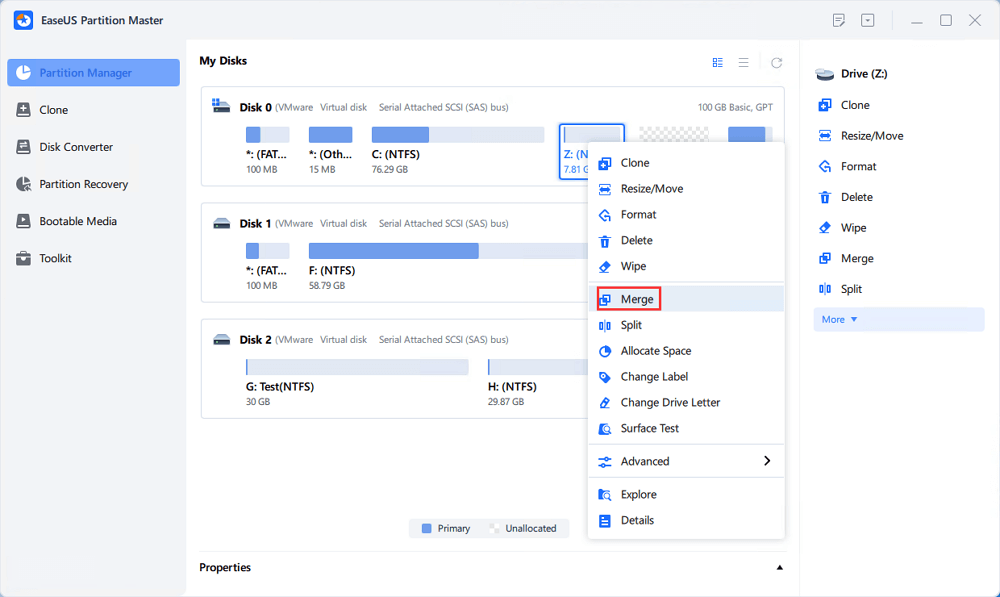
Step 2. Select a non-adjacent partition to merge, click "OK".
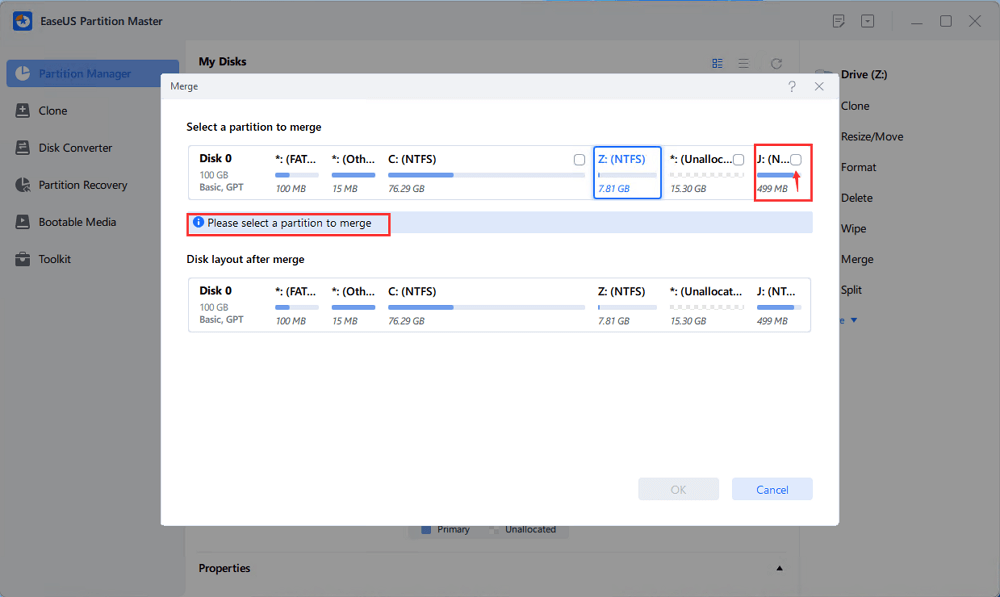
Step 3. Select the target partition you want to keep, and click "OK" to merge the non-adjacent partition into it.
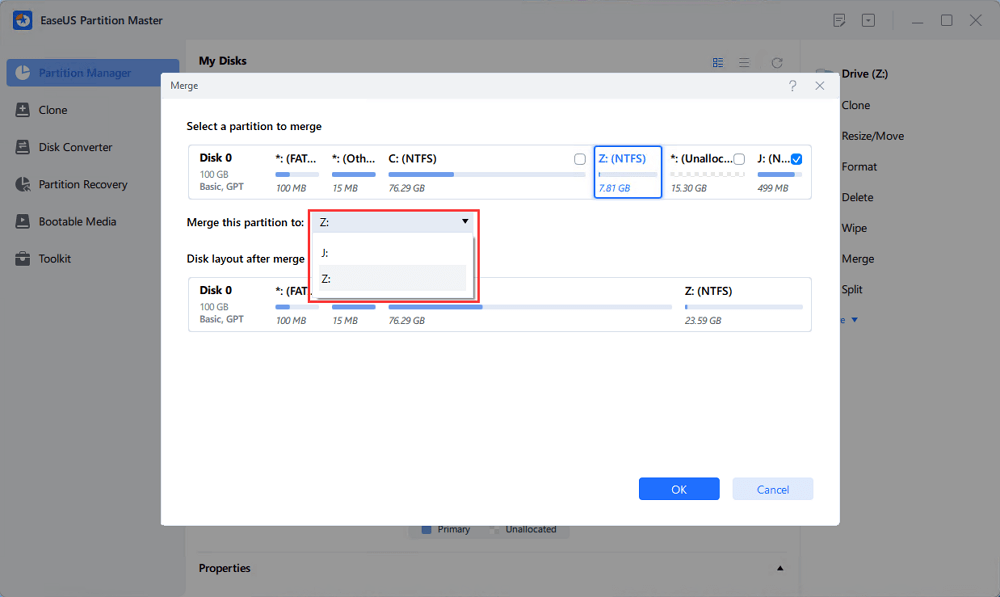
Step 4. Click the "Execute Task" button and click "Apply" to start merging partitions.
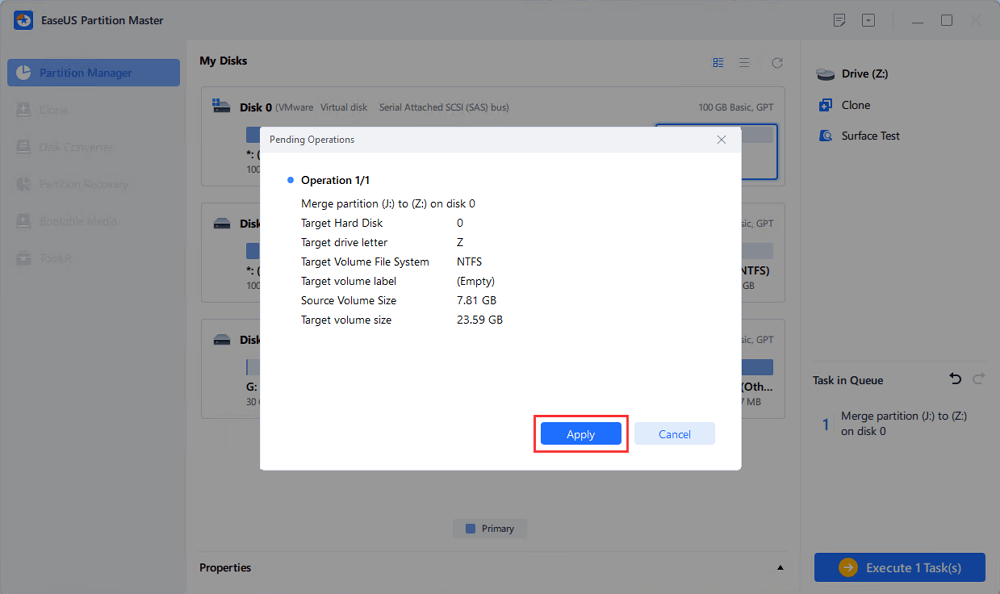
There is a case from Microsoft:
Want to merge unallocated space WIndows 11? This guide helps! To merge two unallocated partitions directly, you can use EaseUS Partition Master. First, it helps you to create a partition using one unallocated partition. Then, you can combine the partition with the other unallocated partition, whether adjacent or nonadjacent.
Here is how to merge two unallocated partitions on Windows 11/10/8/7:
Step 1. Launch EaseUS Partition Master and go to the "Partition Manager" part.
Step 2. Right-click one unallocated partition and click "Create." Follow the prompts to create a new partition using the unallocated space.
Step 3. Then, right-click the new partition and select "Merge." Then, select the unallocated space in the "select a partition to merge" section.
Step 4. Click "OK" and "Execute the task" to continue. Wait for it to finish.
There is a case from Reddit:
If your hard disk is larger than 2TB and initializes it to MBR, it will divide it into two unallocated space in Disk Management. As we know, MBR only supports disk up to 2TB. You need to convert MBR to GPT before merging unallocated space larger than 2TB.

You may try Disk Management to convert it, but it is grayed out. Because the built-in tool can only convert partition format on an empty disk, don't worry. Here is a better solution to convert partition style without wiping any data - EaseUS Partition Master.
Step 1. Download and launch EaseUS Partition Master on your computer.
Step 2. Go to Disk Converter, select "MBR => GPT" and click "Next" to continue.
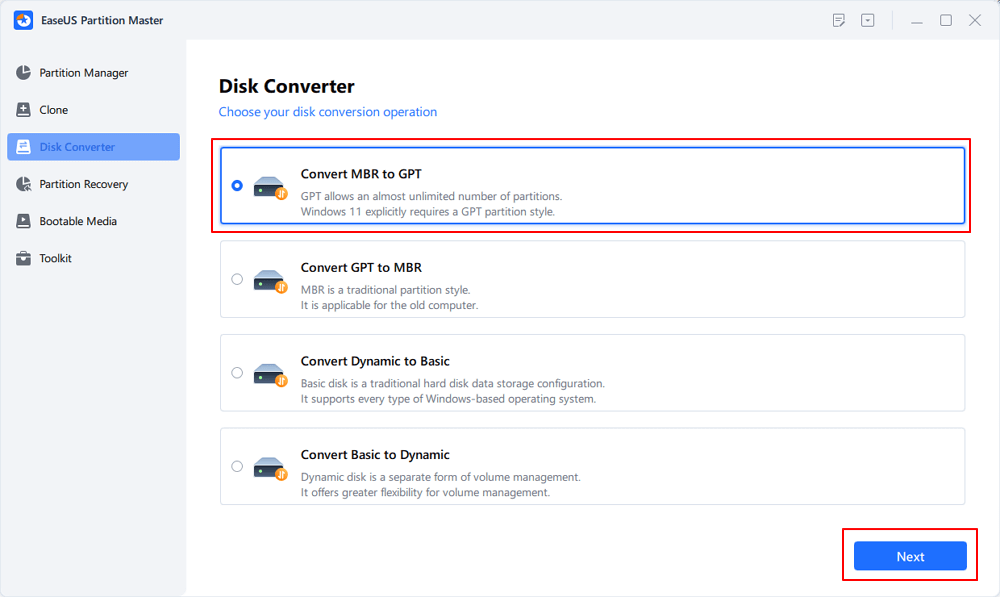
Step 3. Select the target MBR disk that you tend to convert to GPT, and click "Convert" to start the conversion.
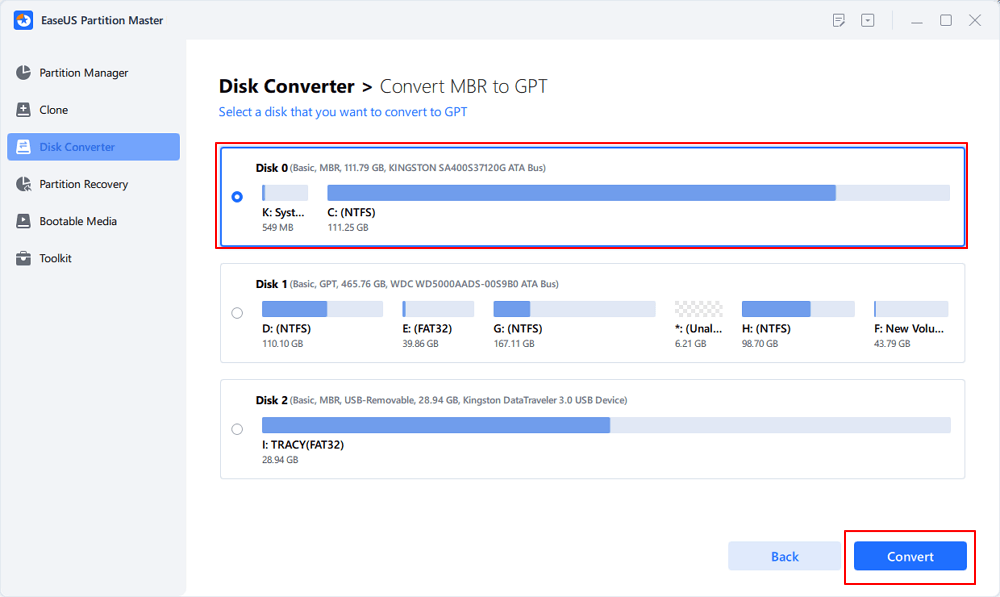
Now you can see the two unallocated spaces become one. Then, you use Disk Management to merge it to another disk or apply EaseUS Partition Master to merge unallocated space in Windows 11/10.

Do you like the two ways to merge unallocated space to C drive? If you like this page, click the link below to share it with more people.
This part introduces how to add unallocated space to C drive or another volume with Disk Management. To merge unallocated space to the C drive with Windows Disk Management, you need to use the "Extend Volume" function.
Open the Disk Management and try the steps one by one.
Step 1: Install and run Disk Management. Right-click the partition you want to add the unallocated space to and then choose Extend Volume to merge Partitions (e.g. C partition).
Step 2: Follow the Extend Volume Wizard and then click Finish.
Step 3: In the pop-up window, you will realize the size of the partition has been increased.

In any case, the unallocated space is not on the neighboring right side of the C drive, you cannot add unallocated space to the C drive because the Extend Volume greyed out.
By contrast, it's more flexible to have EaseUS Partition Master to deal with either an adjacent or non-adjacent unallocated space in Windows 11/10/8.1/8/7/XP/Vista. What are the overwhelming features that make it stand out when it comes to a comfortable and straightforward way to add space to the C drive without losing a single data?
1. Resize/Move partition
Where is the unallocated located? Has it to be on the right side of the C drive? What about the C drive and unallocated space being separated by the drive D, E, or F? It doesn't matter, even if you catch up in all the situations, because you are still empowered to use a simple 'drag and move' method to swallow all the unallocated space into the system drive.
2. Allocate Space
This feature was newly added to the recent software update. The most amazing part is that you don't even consider whether you currently have unallocated space or not, which saves an essential step to shrink one partition to create unallocated space in order to extend the C drive. Windows Disk Management is not expected to own this feature in the coming days.
We learned that there are two ways to add unallocated space to a partition - Disk Management and EaseUS Partition Master. if there is adjacent unallocated space behind the partition, you can combine them via Disk Management. If there is no such unallocated space, EaseUS Partition Master will be the safest and most effective method, which allows you to merge adjacent or non-adjacent unallocated space and also allows you to merge two unallocated spaces directly. Please share this article to help more people.
Have two unallocated partitions on your hard disk? You need to merge them to utilize the disk space more efficiently. Read the following to learn more.
1. How to delete unallocated partitions?
You can't delete an unallocated partition directly, but you can create a new partition using the unallocated space or merge it with another partition to reuse it.
#1. Create a new partition with the unallocated space
#2. Extend an existing partition with unallocated space
2. How to merge two unallocated partitions directly?
To merge two adjacent unallocated partitions directly, you need to create a new partition with the left unallocated space and extend the new partition with another unallocated partition via Disk Management.
To merge two non-adjacent unallocated partitions directly, turn to EaseUS Partition Master. It allows you to create a new partition with one unallocated partition and merge the partition with another nonadjacent unallocated partition.
3. How to recover data from an unallocated partition?
To recover data from an unallocated partition, you need data recovery software. You can choose a trusted data recovery software such as EaseUS Data Recovery Wizard to help fix an unallocated partition without losing data.
How Can We Help You
Sherly joined EaseUS in 2022 and she has always loved writing articles and enjoys the fun they bring. She receives professional training here, focusing on product performance and other relative knowledge. She has written over 200 articles to help people overcome computing issues.
Jean is recognized as one of the most professional writers in EaseUS. She has kept improving her writing skills over the past 10 years and helped millions of her readers solve their tech problems on PC, Mac, and iOS devices.
It won't hot image your drives or align them, but since it's coupled with a partition manager, it allows you do perform many tasks at once, instead of just cloning drives. You can move partitions around, resize them, defragment, and more, along with the other tools you'd expect from a cloning tool.
Read MoreI love that the changes you make with EaseUS Partition Master Free aren't immediately applied to the disks. It makes it way easier to play out what will happen after you've made all the changes. I also think the overall look and feel of EaseUS Partition Master Free makes whatever you're doing with your computer's partitions easy.
Read MorePartition Master Free can Resize, Move, Merge, Migrate, and Copy disks or partitions; convert to local, change label, defragment, check and explore partition; and much more. A premium upgrade adds free tech support and the ability to resize dynamic volumes.
Read MoreIt won't hot image your drives or align them, but since it's coupled with a partition manager, it allows you do perform many tasks at once, instead of just cloning drives. You can move partitions around, resize them, defragment, and more, along with the other tools you'd expect from a cloning tool.
Read MoreI love that the changes you make with EaseUS Partition Master Free aren't immediately applied to the disks. It makes it way easier to play out what will happen after you've made all the changes. I also think the overall look and feel of EaseUS Partition Master Free makes whatever you're doing with your computer's partitions easy.
Read MoreRelated Articles
How Do I Use DiskPart to Delete All Partitions in Windows? Your 2025 Guide Is Here
![]() Tracy King/2025/04/28
Tracy King/2025/04/28
How to Format SD Card FAT32 Windows 11
![]() Brithny/2025/04/28
Brithny/2025/04/28
How to Make Nintendo 3DS System Read SD Card Over 32GB
![]() Daisy/2025/04/28
Daisy/2025/04/28
Diskpart Delete Server Partition: Get Solutions to Delete Recovery Partition
![]() Tracy King/2025/04/28
Tracy King/2025/04/28
EaseUS Partition Master

Manage partitions and optimize disks efficiently
Your best companion for disk partitioning, MBR to GPT/GPT to MBR conversion,even OS migration
CHOOSE YOUR REGION
Start Your Free Trial!
Sign up to our newsletter, stay updated on news and exclusive offers from EaseUS. Don't worry, if you change your mind, you can unsubscribe at any time, free of charge. We value your privacy (Privacy Policy).
Start Your Free Trial!
Sign up to our newsletter, stay updated on news and exclusive offers from EaseUS. Don't worry, if you change your mind, you can unsubscribe at any time, free of charge. We value your privacy (Privacy Policy).